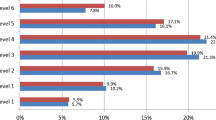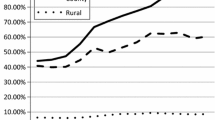Abstract
This study examines the gender gaps in mathematics and physics in Chinese middle schools. The data is from the Education Bureau management database which includes all middle school students who took high school entrance exam in a district of Beijing from 2006–2013. The ordinary least square model and quantile regression model are applied. This study consistently shows that the gender gap is unfavorable toward female students in mathematics and physics while favorable toward female students in Chinese and English. Gender gaps favoring males in math and physics become more noticeable among the students who receive the top tier scores in math and physics testing. However, females’ students’ advantage in Chinese and English decreases along the distribution from the bottom to the top percentiles. There are significant intersections between rural residency and gender. Rural students (regardless of gender) perform less well than urban students in all subjects and rural female student show the worst testing scores compared with the other subgroups in mathematics and physics.



Similar content being viewed by others
Notes
In China, there are two types of middle school: “standard middle schools” (average middle schools) and “weak middle schools” (below average middle schools). The schools whose average total scores for High School Entrance Exam are lower than those of “standard middle schools” by more than 50% of a standard deviation are classified as “weak middle schools”. In addition, there are two types of high school in China: “key high schools” and “average high school”. “Key high schools” not only enjoyed high public appropriation and preferential policies on enrollment, but also are assigned the best teachers (Zhang et al. 2014).
References
Aiken, L. (1986). Sex differences in mathematical ability: A review of the literature. Educational Research Quarterly, 10(4), 25–35.
Arnold, C. L. (1995). Using HLM and NAEP data to explore school correlates of 1990 mathematics and geometry achievement in grades 4, 8, and 12: Methodology and results. Research and Development Report. US Government Printing Office, Superintendent of Documents, Mail Stop: SSOP, Washington, DC 20402-9328.
Baker, D. P. & Jones, D. P. (1993). Creating gender equality: Cross-national gender stratification and mathematical performance. Sociology of Education, 66(2), 91–103.
Baram-Tsabari, A., & Yarden, A. (2011). Quantifying the gender gap in science interests. International Journal of Science and Mathematics Education, 9(3), 523–550. doi:10.1007/s10763-010-9194-7.
Bedard, K., & Cho, I. (2010). Early gender test score gaps across OECD countries. Economics of Education Review, 29(3), 348–363. doi:10.1016/j.econedurev.2009.10.015.
Bharadwaj, P., Giorgi, G. D., Hansen, D. & Neilson, C. (2012). The gender gap in mathematics: Evidence from low and middle income countries, No 18464. NBER Working Papers, National Bureau of Economic Research, Inc. doi:10.3386/w18464.
Britner, S. L. (2008). Motivation in high school science students: A comparison of gender differences in life, physical, and earth science classes. Journal of Research in Science Teaching, 45(8), 955–970. doi:10.1002/tea.20249.
Carnevale, A. P., Strohl, J., & Melton, M. (2011). What’s it worth? The economic value of college majors, 8–10. Washington, DC: Georgetown University Center on Education and the Workforce.
Casey, M. B., Nuttall, R., Pezaris, E., & Benbow, C. P. (1995). The influence of spatial ability on gender differences in mathematics college entrance test scores across diverse samples. Developmental Psychology, 31(4), 697–705. doi:10.1037/0012-1649.31.4.697.
Catsambis, S. (1995). Gender, race, ethnicity, and science education in the middle grades. Journal of Research in Science Teaching, 32(3), 243–257. doi:10.1002/tea.3660320305.
Ceci, S. J., Williams, W. M., & Barnett, S. M. (2009). Women’s underrepresentation in science: Sociocultural and biological considerations. Psychological Bulletin, 135(2), 218–261. doi:10.1037/a0014412.
Ellison, G., & Swanson, A. (2010). The gender gap in secondary school mathematics at high achievement levels: Evidence from the american mathematics competitions. Journal of Economic Perspectives, American Economic Association, 24(2), 109–128. doi:10.3386/w15238.
Entwisle, D. R., Alexander, K. L., & Olson, L. S. (1994). The gender gap in math: Its possible origins in neighborhood effects. American Sociological Review, 59(6), 822–838. doi:10.2307/2096370.
Fryer, R. G., Jr., & Levitt, S. D. (2009). An empirical analysis of the gender gap in mathematics. American Economic Journal: Applied Economics, 2(2), 210–240. doi:10.3386/w15430.
Gallagher, A., & DeLisi, R. (1994). Gender differences in scholastic aptitude test—Mathematics problem solving among high-ability students. Journal of Educational Psychology, 86, 204–211.
Guiso, L., Monte, F., Sapienza, P., & Zingales, L. (2008). Culture, gender, and math. Science, 320(5880), 1164–1165. doi:10.1126/science.1154094.
Halpern, D. F. (2011). Sex differences in cognitive abilities (4th ed.). Oxford, UK: Psychology Press, Taylor & Francis Group.
Holmlund, H., & Sund, K. (2008). Is the gender gap in school performance affected by the sex of the teacher? Labour Economics, 15(1), 37–53. doi:10.1016/j.labeco.2006.12.002. (gender, culture, mathematics).
Hyde, J. S., Fennema, E., Ryan, M., Frost, L. A., & Hopp, C. (1990). Gender comparisons of mathematics studies and effects: A meta-analysis. Psychology of Women Quarterly, 14, 299–324.
Hyde, J. S., & Mertz, J. E. (2009). Gender, culture, and mathematics performance. Proceedings of the National Academy of Sciences, 106(22), 8801–8807. doi:10.1073/pnas.0901265106.
Jacobs, J. E. (2005). Twenty-five years of research on gender and ethnic differences in math and science career choices: What have we learned? New Directions for Child and Adolescent Development, 2005(110), 85–94. doi:10.1002/cd.151.
Jacobs, J. E., Davis-Kean, P., Bleeker, M., Eccles, J. S., & Malanchuk, O. G. (2004). “I can, but i don’t want to”: The impact of parents, interests, and activities on gender differences in math. In A. Gallagher & J. Kaufman (Eds.), Gender differences in mathematics: An integrative psychological approach (pp. 246–263). Cambridge: Cambridge University Press.
Lai, F. (2010). Are boys left behind? The evolution of the gender achievement gap in Beijing’s middle schools. Economics of Education Review, 29(4), 383–399. doi:10.1016/j.econedurev.2009.07.009.
Langdon, D., McKittrick, G., Beede, D., & Khan, B. (2011). STEM: Good jobs now and for the future. ESA Issue Brief 3(11). US Department of Commerce.
Levine, S. C., Vasilyeva, M., Lourenco, S. F., Newcombe, N. S., & Huttenlocher, J. (2005). Socioeconomic status modifies the sex difference in spatial skill. Psychological Science, 16(11), 841–845. doi:10.1111/j.1467-9280.2005.01623.x.
Lummis, M. & Stevenson, H. W. (1990). Gender differences in beliefs and achievement: A cross-cultural study. Developmental Psychology, 26(2), 254–263. doi:10.1037/0012-1649.26.2.254.
Marks, G. N. (2008). Accounting for the gender gaps in student performance in reading and mathematics: evidence from 31 countries. Oxford Review of Education, 34(1), 89–109.
Muller, C. (1998). Gender differences in parental involvement and adolescents’ mathematics achievement. Sociology of Education. doi:10.2307/2673174.
Mullis, I., Martin, M., Gonzalez, E., Gregory, K., Garden, R., O’Connor, K., et al. (2000). TIMSS 1999. Findings from IEA’s Repeat of the Third International Mathematics and Science Study at the Eighth Grade. International Mathematics Report. Boston.
Neuschmidt, Oliver, Barth, J., & HastedtTrends, D. (2008). Trends in gender differences in mathematics and science (TIMSS 1995–2003). Studies in Educational Evaluation, 34(2), 56–72. doi:10.1016/j.stueduc.2008.04.002.
Niederle, M. & Vesterlund, L. (2010). Explaining the gender gap in math test scores: The role of competition. The Journal of Economic Perspectives, 24(2), 129–144. http://www.jstor.org/stable/25703504
Nosek, B. A., Smyth, F. L., Sriram, N., Lindner, N. M., Devos, T., Ayala, A., et al. (2009). National differences in gender–science stereotypes predict national sex differences in science and math achievement. Proceedings of the National Academy of Sciences, 106(26), 10593–10597. doi:10.1073/pnas.0809921106.
Ors, E., Palomino, F., & Peyrache, E. (2013). Performance gender gap: Does competition matter? Journal of Labor Economics, 31(3), 443–499.
Penner, A. M., & Paret, M. (2008). Gender differences in mathematics achievement: Exploring the early grades and the extremes. Social Science Research, 37, 239–253.
Robinson, J. P., & Lubienski, S. T. (2011). The development of gender achievement gaps in mathematics and reading during elementary and middle school examining direct cognitive assessments and teacher ratings. American Educational Research Journal, 48(2), 268–302. doi:10.3102/0002831210372249.
Spencer, S. J., Steele, C. M., & Quinn, D. M. (1999). Stereotype threat and women’s math performance. Journal of Experimental Social Psychology, 35, 4–28.
Stoet, G., & Geary, D. C. (2012). Can stereotype threat explain the gender gap in mathematics performance and achievement? Review of General Psychology, 16(1), 93–102. doi:10.1037/a0026617.
Tsui, M. (2007). Gender and mathematics achievement in China and the United States. Gender Issues, 24(3), 1–11. doi:10.1007/s12147-007-9044-2.
Valian, V. (2007). Women at the top in science–and elsewhere. In S. J. Ceci & W. M. Williams (Eds.), Why aren’t more women in science? Top researchers debate the evidence (pp. 27–37). Washington, DC: American Psychological Association.
Warrington, M., & Younge, M. (2000). The other side of the gender gap. Gender and Education, 12(4), 493–508. doi:10.1080/09540250020004126.
Zhang, Y., & Tsang, M. (2015). Gender gap in the national college entrance exam performance in China—A case study of a typical Chinese municipality. Asia Pacific Education Review, 16(1), 27–36. doi:10.1007/s12564-014-9351-8.
Zhang, Y., Chen, D. & Wang, W. (2014). The heterogeneous effect of ability grouping on students’ national college entrance exam performance. International Journal of Educational Development, 39, 80–91.
Author information
Authors and Affiliations
Corresponding author
Additional information
Chinese “middle school” (also called “junior high school” in China) enrolls students ages 12–15 for grades 7–9 and it is approximately equivalent to U.S. middle school (grades 6–8, plus kindergarten).
Rights and permissions
About this article
Cite this article
Li, M., Zhang, Y. & Wang, Y. Gender Gap in Mathematics and Physics in Chinese Middle Schools: A Case Study of a Beijing’s District. Urban Rev 49, 568–584 (2017). https://doi.org/10.1007/s11256-017-0409-x
Published:
Issue Date:
DOI: https://doi.org/10.1007/s11256-017-0409-x




